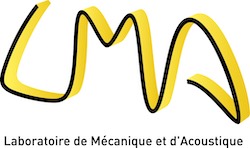Alexis Bottero
Numerical simulations of T-wave generation and conversion at shores : influence of slope angles and of media characteristics
Abstract : The term T-waves is generally associated to acoustic signals generated by earthquakes which ends up traveling horizontally in the ocean at the speed of sound in the water. After traveling over long ranges they reach the shore, where they can be reflected or converted into (visco)elastic waves. For almost 90 years, T-waves have been the subject of numerous studies in order to identify their generation mechanisms. Generally, it is supposed that seismic waves are converted to horizontally propagating T-waves by a sloping sea bottom before entering the SOFAR channel. In this study, we present a two-step parametric study of the influence of the slope on a typical T-wave generation/conversion scenario. We use a 2D spectral-element method that allows for full-waveform modeling of wave propagation. In a first step we study the amount of acoustic energy channeled from a deep earthquake below a sloping sea-floor. We then model the reflection/transmission of T-waves at the shore. Our results suggest that an optimum slope angle exists for T-wave generation, and that a non-negligible amount of the channeled energy can be reflected at a sloping shore. We find no evidence of a significant influence of the SOFAR channel.
Louis Joëssel
Viscoplasticité de cristaux poreux
Auteurs : Louis Joëssel, Pierre-Guy Vincent, Mihail Gărăjeu, Martín I. Idiart
Résumé : La température élevée et l’irradiation prolongée que subissent les aciers inoxydables austénitiques à l’intérieur des cuves (internes de cuve) des réacteurs nucléaires peuvent entraîner l’apparition de cavités intragranulaires. Ces observations motivent la prise en compte de l’anisotropie cristalline pour modéliser le comportement effectif viscoplastique de polycristaux poreux. Ce travail propose une étude détaillée d’un monocristal poreux à symétrie cubique. Trois approches sont considérées. La première approche consiste à idéaliser le monocristal poreux comme un assemblage de sphères creuses pour déterminer une borne du comportement effectif. La seconde approche consiste à idéaliser le monocristal poreux comme un laminé de rang infini pour estimer le comportement effectif. La troisième démarche consiste à idéaliser le monocristal poreux comme une microstructure périodique pour estimer le comportement effectif via des simulations numériques en champ complet par une méthode basée sur la transformée de Fourier rapide. Les résultats obtenus par ces trois approches sont comparés et discutés.


